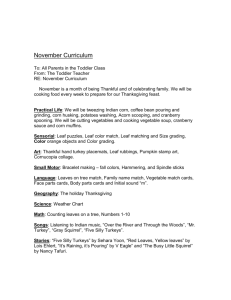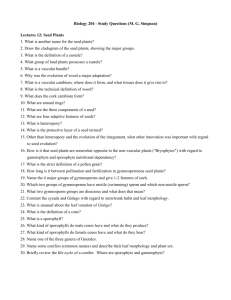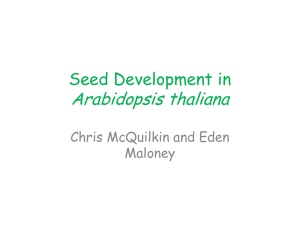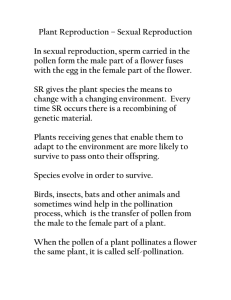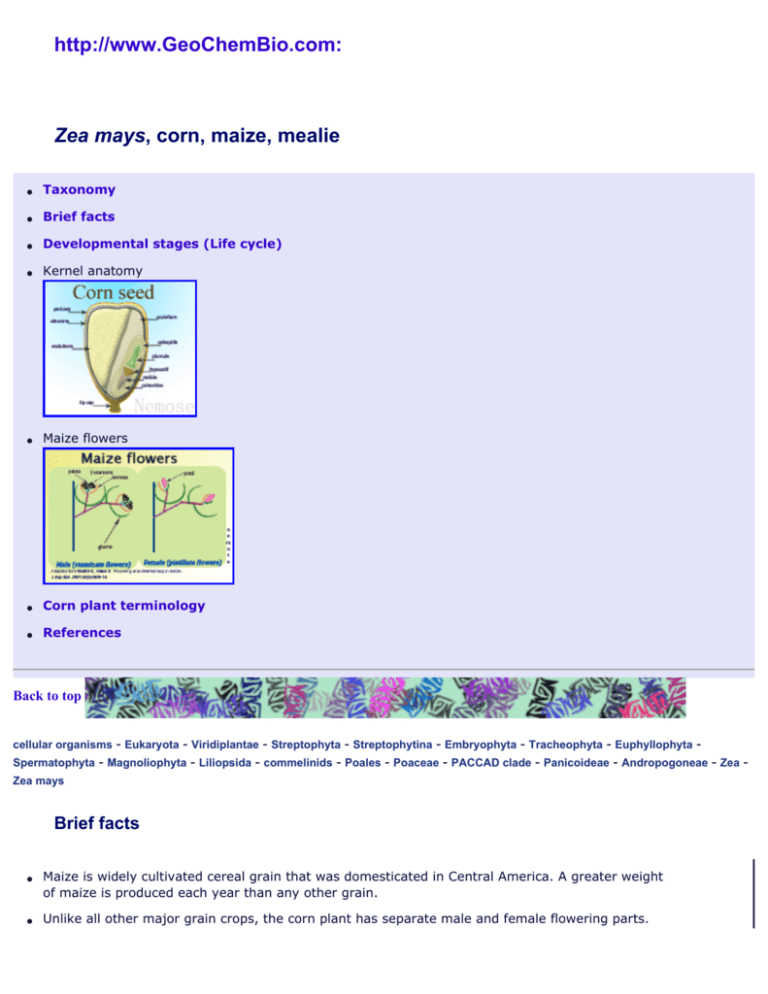
http://www.GeoChemBio.com:
Zea mays, corn, maize, mealie
●
Taxonomy
●
Brief facts
●
Developmental stages (Life cycle)
●
Kernel anatomy
●
Maize flowers
●
Corn plant terminology
●
References
Back to top
- Eukaryota - Viridiplantae - Streptophyta - Streptophytina - Embryophyta - Tracheophyta - Euphyllophyta - Magnoliophyta - Liliopsida - commelinids - Poales - Poaceae - PACCAD clade - Panicoideae - Andropogoneae - Zea -
cellular organisms
Spermatophyta
Zea mays
Brief facts
●
●
Maize is widely cultivated cereal grain that was domesticated in Central America. A greater weight
of maize is produced each year than any other grain.
Unlike all other major grain crops, the corn plant has separate male and female flowering parts.
Developmental stages (life cycle)
Life Cycle Stages
The staging system divides corn development into vegetative (V) and reproductive (R) stages. V stages are designated
VE (emergence), Vn, where n represents the emerging leaf's order number, and VT (tasseling). Depending on the hybrid
each plant develops 20-21 total leaves, silks about 65 days after emergence, and matures about 125 days after
emergence.
●
seed stage MeSH
❍
dormant seed
❍
germinating seed
embryonic shoot (plumule) and
embryonic plant roots (radicle) emerge
and grow upwards and downwards
respectively; seed should be covered by
1-1 1/2 inches of soil to allow for
adequate root system to develop
●
vegetative
❍
emergence
stage VE; coleoptile leaf (1st) visible;
emergence takes from 6-21 days
depending on weather conditions
❍
seedling MeSH
V1 - V4 (1-4 collared leaves are visible);
until about 2 weeks after emergence;
early whorl stage; functions of seminal
roots (roots that grew directly from the
seedling) are rapidly taken over by
permanent nodal root system, which
begins development at each progressively
higher node on the stalk (up to 7 to 10
nodes total) and becomes the major
supplier of water and nutrients to the
plant by the V6
❍
first internode
elongation
V5-V6; may lost the coleoptile leaf by this
time; plant is approx. 8 inches tall;
growing point is just below the ground
surface therefore hail and freeze are not
that harmful whereas flood, especially in
combination with high temperatures, can
be deadly; the first internode (~1/2 inch)
elongates just below the node of 5th leaf;
this is important reference point for crop
growth staging; later, when lower leaves
will dry up and fall off, the fifth leaf node
can be used as a reference for counting
to the top leaf collar
❍
ear and tassel
initiation
V6; early whorl stage; 3-4 weeks after
emergence; lower leaves (1-4) dry up;
tassel formation has been initiated;
growing point and tassels are above soil
surface (increased vulnerability to freeze
and hail); tillers (ear shoots) begin
developing
❍
stem elongation
stages V7-V17; mid-whorl to late
whorl; 4-6 weeks after emergence; plant
grows rapidly; by V10 new leaf stage
occurs every 2-3 days; size of ear and
number of potential kernels being
established; an ear shoot will develop
from every above-ground node, except
the last six to eight nodes below the
tassel; growth of most lower stalk ears
eventually slows, and only the upper one
or two shoots develop into a harvestable
ear; hybrids that produce more than one
harvestable ear are termed prolific
❍
tassel emergence
VT; 7.5-8.5 weeks after emergence;
tassel fully emerged and pollen shed
begins 2-3 days prior to silking; tassel is
usually fully emerged and stretched out
before any pollen is shed
●
reproductive
❍
silking
R1; most critical stage; approx. 8.5-9
weeks after emergence; silks are visible
outside the husks; it takes ~24 h for
pollen grain to grow down the silk and
fertilize the egg; generally 2 -3 days are
required for all kernels to be fertilized on
a single ear; silks continue to grow 2.53.8 cm (1 - 1 1/2 inches each day until
fertilized
❍
ripening
■
blister stage
R2 stage; about 10-14 days after silking;
kernels are white, filled with clear fluid
and distinct from surrounding cob;
kernels are beginning dry matter
accumulation; relocation of nutrients
from the leaves and stem to the ear
begins
■
milk stage
R3 stage; about 18-22 days after silking;
rapid grain filling period; kernels begin to
have yellow colour; inner fluid is milky
white
■
dough stage
R4 stage; about 24-28 days after silking;
top of kernel begins to firm up; usually
four embryonic leaves have formed by
this time; the reduced fluid and increased
solids within the kernel at this time
produce a doughy consistency
■
dent stage
R5 stage; about 35-42 days after silking;
all kernels are dented or denting; starch
layer appears shortly after denting as a
line across the kernel when it is viewed
from the opposite embryo side
■
1/2 maturity
a hard white layer of starch reaches half
way down the kernel
❍
black layer
R6 stage; plant reached physiological
maturity; all kernels on the ear have
attained their maximum dry weight or
maximum dry matter accumulation; hard
starch layer has advanced completely to
the cob now and a black or brown
abscission layer has formed
Corn seed anatomy
Maize flowers
Plant Compoments
Corn plant terminology
●
tassel
inflorescence of male flowers; the tassel
consists of several long, indeterminate
branches bearing short determinate
branches (spikelet pairs) that bear two
spikelets (compact auxiliary btanches of
grass inflorescence that in maize consists
of two bracts subtending one reduced
male flower)
❍
stamen
pollen-producing reproductive organs
which are collectively referred as
androecium
■
stalk
also filament; the part of the stamen
on which anther develops
■
anther
the terminal part of a stamen in which
the pollen grains are produced
■
microspore
smaller of the two types of
spore produced in heterosporous
plants; develops in the pollen sac
into a male gametophyte
■
male
gametophyte
microspores divide twice
to produce 3 celled
pollen grain/tube
(a male gametophyte);
two of the cells are sperm;
other is called vegetative
cell , or tube cell
■
sperm cell
two sperm cells
are produced;
one sperm cell
fuses with the
egg resulting
in zygote;
other sperm cells
fuses with central
cell giving start
to development of
triploid tissue
called endosperm
which surrounds
the embryo and serves
an absorbtive/nutritive
function in seed
■
tube cell
haploid cell that
comprise two sperm
cells and facilitates
delivery of the
sperm into ovary
●
ear
inflorescence of female flowers; it
consists of a single spike with short
branches each producing two singleflower spikelets
❍
pistil
■
style
slender part of a pistil, situated
between the ovary and the stigma (main
part of silk)
■
stigma
the receptive apex of the pistil of a flower,
on which pollen is deposited at pollination
■
ovary
■
ovule
■
megaspore
also called macrospore;
gives rise to female
gametophyte
■
female
gametophyte
also called
megagametophyte
or embryo sac;
the female gametophyte
consists of 7 cells
■
egg
one of small 6
cells, which fuses
with the sperm cell
giving rise to the
plant embryo
■
central cell
large cell, which
has 2 haploid, or
polar nuclei; it
fuses with the
second sperm cell
giving rise to
triploid tissue
called endosperm
●
leaf MeSH
❍
leaf blade
❍
sheath
part of the leaf originating from the node
and running parallel to the culm or stem
itself
❍
ligule
a membrane that is located between the
culm and the leaf blade
●
seed MeSH
corn seed is also called kernel and
known botanically as a caryopsis
❍
pericarp
the tissue surrounding a seed that
develops from the ovary wall of the
flower; in corn is also called husk, hull,
or bran
■
epidermis
■
mesocarp
■
cross cells
■
tube cells
■
seed coat
a testa; outer coat of a seed
❍
endosperm
the triploid nutritive tissue formed within
the embryo sack of seed plants; the
endosperm provides about 83 percent of
the kernel weight
■
soft endosperm
■
horny endosperm
■
aleurone
a granular protein found in the
endosperm of many seeds or forming the
outermost layer in cereal grains
❍
embryo
also called a germ
■
plumule
the rudimentary terminal bud of a plant
embryo situated at the end of the
hypocotyl, consisting of the epicotyl and
of immature leaves (3rd and 4th leaves)
■
epicotyl
the stem of a seedling or embryo located
between the cotyledons and the first true
leaves
■
coleoptile
a protective sheath enclosing the shoot
tip and embryonic leaves of grasses
■
cotyledon
seed leaf (as opposing to the true leaf);
also called scutellum
■
hypocotyl
the part of the axis of a plant embryo or
seedling plant that is below the
cotyledons
■
radicle
embryonic root
■
coleorhiza
a protective sheath enclosing the
embryonic root of grasses
❍
tip cap
dead tissue found where the kernel joins
the cob
References
PubMed articles
●
●
●
Bortiri E, Hake S. Flowering and determinacy in maize. J Exp Bot. 2007;58(5):909-16. Epub 2007 Mar 3.
PMID: 17337752
Ritchie SW, Hanway JJ and Benson GO. How a Corn Plant Develops. Special Report No. 48. Iowa State
University of Science and Technology Cooperative Extension Service Ames, Iowa, June 1993
Major topic Zea mays - free full text articles in PubMed
Websites
●
Corn Production
●
Corn Development and Key Growth Stages
Last updated 09/13/09
nemose@live.com
©Nemose 2008 - 2009 All rights reserved

